When the Calgary Flames and Carolina Hurricanes agreed to a trade on June 23, 2018 that sent defenseman Dougie Hamilton to Carolina, it had the potential to be monumental. It meant breaking up a defense pair of Mark Giordano and Hamilton that had been the Flames’ best and one of the league’s best pairs the past two seasons. It was a move that could have had serious repercussions on both players as well as both teams. However, as it’s played out in the early portions of the season, Giordano and Hamilton have been fine apart from each other.
Hamilton’s Arrival in Calgary
As most fans are aware of, Hamilton wasn’t a lifelong Calgary Flame. Rather, they acquired him from the Boston Bruins in June 2015, nearly three years to the day before his trade to the Hurricanes. As a Bruin, he played in 178 games with 22 goals and 83 points across three seasons from age 19 through 21. He primarily played on a pair with Zdeno Chara and had success, including his final season when he averaged over 20 minutes a game, netted double-digit goals, and totaled 40-plus points for the first times in his career.
When the Flames acquired him, Hamilton had just played the final year of his rookie contract and didn’t have a new deal in place. They quickly inked him to a six-year deal and he played the majority of the 2015-16 season, his first in Calgary, with Kris Russell as his partner. In over 500 minutes of five-on-five ice time together, the pair didn’t have strong metrics with sub-50 percent control of shots, scoring chances, and goals.

That same season, Giordano generally played on a pair with T.J. Brodie and the duo controlled just over 50 percent of the same categories. In 2016-17, new Flames head coach Glen Gulutzan put Giordano and Hamilton together for the first time and the best defense pair in the league was established.
Putting Giordano and Hamilton Together
During the 2016-17 and 2017-18 seasons, the Giordano/Hamilton pair was Calgary’s most used with over 900 shared five-on-five minutes in 2016-17 and over 1,200 minutes last season. In 2017-18, Giordano played over 88 percent of his five-on-five minutes with Hamilton as his partner.
First Season as Partners
In their inaugural season as a pair, Giordano and Hamilton played nearly 300 more five-on-five minutes than any other Flames pair. They excelled from the start with 66.2 percent control of goals and 58.3 percent control of shots and the team attempted 34.1 shots per-60 at five-on-five with them on the ice. Among Flames pairs with at least 200 shared minutes, they were tops in all three. Conversely, Calgary allowed 24.4 five-on-five shots per-60 with them on the ice, second-best on the team.
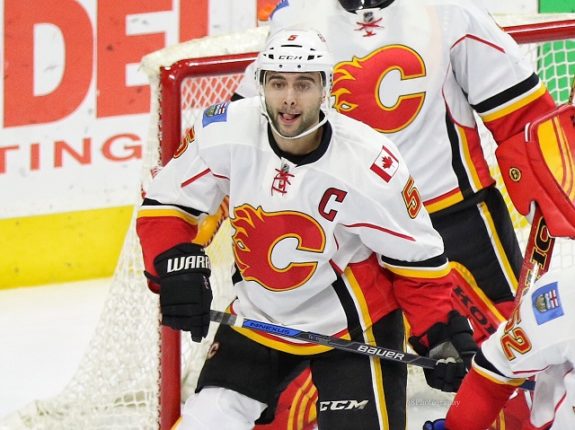
Further Gelling in 2017-18
Giordano and Hamilton played together even more last season with 1,258 shared five-on-five minutes, nearly 200 more than Calgary’s second-most deployed pair of Travis Hamonic and Brodie. Giordano and Hamilton were again the team’s best pair and led in control of goals and shots and the team generated its most shots and allowed its fewest shots per-60 with them deployed.
Relative to the League
In their two seasons as a pair, Giordano and Hamilton rated well compared to the league. Among pairs with at least 1,000 shared five-on-five minutes, they ranked first in shot control and in attempted shots with 36.0 shots per-60. Additionally, they were top-five in goals for percentage and shots against per-60 and tied for sixth in goals allowed per-60.
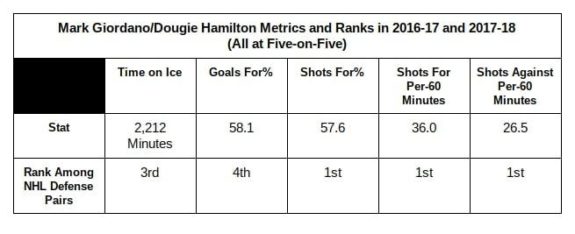
Impact on Each Other
What was impressive about Giordano and Hamilton as a pair was that while neither are considered top-five at their position, both managed to have a positive impact on the other, which allowed the pair to become so dynamic. In 2016-17, they had great metrics together and controlled over 55 percent of shots, goals, scoring chances, and high danger scoring chances when together.
When Hamilton had a different partner, the team’s control of goals and high danger scoring chances dropped to below 50 percent while shots and scoring chances were just above 50 percent. When Giordano was with a partner other than Hamilton, his metrics dropped below 50 percent across the board. Furthermore, when the Flames deployed pairs that featured neither Giordano nor Hamilton, the team controlled less than 49 percent in all four areas.
The same was true last season, again with over 52 percent control in every area when together. Without Giordano, Hamilton’s metrics dropped to almost exactly 50 percent across the board. Meanwhile, Giordano’s control of goals dropped below 50 percent while his other metrics were just above that threshold. When neither were on the ice, the team’s metrics fell considerably.
Hamilton Goes to Raleigh
When the Flames traded Hamilton to the Hurricanes, they knew they were giving up one of their best players and were going to struggle to recoup enough value to make the trade equal. There was speculation as to why he was traded, most of which was rooted in rumors that he wasn’t bothered by the culture of losing that persisted in Calgary. Regardless of the validity of those rumors, adding a top pair blueliner to the already-capable defense in Carolina has allowed for a relatively smooth transition.
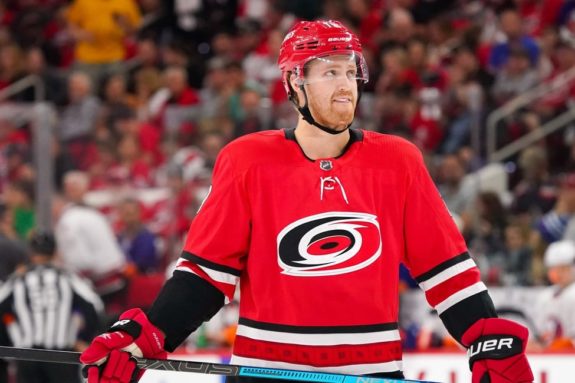
Since the start of the season, Hamilton has mostly paired with 24-year-old Jaccob Slavin, both at five-on-five and on the power play. Slavin has been a productive player in his career with 15 goals and 84 points in 227 games. He also averaged at least 20 minutes per game in all three full seasons entering this season. He spent the majority of last season on a pair with Brett Pesce and the duo had strong metrics with Slavin possessing the stronger numbers.
Finding a New Defense Partner
So far in 2018-19, Hamilton and Slavin have picked up where each left off last season. In 99 shared five-on-five minutes, they have controlled at least 60 percent of goals and shots, ranking second in both among Carolina defense pairs. They also lead the team’s pairs in five-on-five minutes and in shot attempts with 44.1 per-60. They have accomplished this while starting in the offensive zone 30.8 percent of the time, lowest among the Hurricanes defense pairs with at least 50 shared minutes.
Relative to other pairs in the league with at least 50 minutes together, Hamilton and Slavin rank sixth in five-on-five minutes and are in the top-five in shots generated per-60. They are also tied for 19th in goal control and have the 31st-highest offensive zone starting percentage.
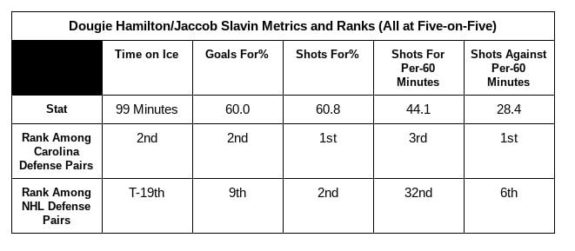
Metrics Bode Well for Both Players
When deployed, the Hamilton/Slavin pair has controlled play by a considerable margin. So far they have controlled over 55 percent of shots, goals, scoring chances, and high danger chances at five-on-five. This includes 60.8 percent of shots, which as I indicated above, ranks ninth in the league. Both players have also done well to make the other better.
When separate, which has been less than 30 five-on-five minutes on the season, Hamilton has a higher control of scoring chances than when they are together. Meanwhile, when he is partnered with someone other than Hamilton, all of Slavin’s metrics except shot control drop relative to when he’s with Hamilton. Yet Slavin’s goal and shot control are higher than those of Hamilton’s when they are apart.
When the Hurricanes deploy a pair that doesn’t include Hamilton or Slavin, their metrics are still strong, with at least 52 percent control in all areas. They are actually higher in control of goals and high danger chances without the pair on the ice. Understandable, as this was a team that finished top-five in the league in control of shots and scoring chances last season.
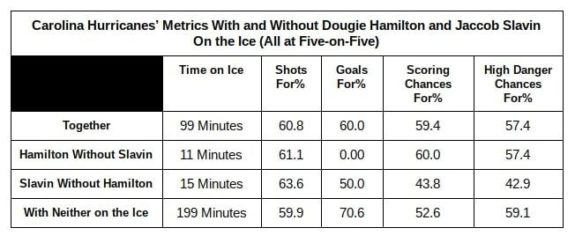
Giordano Back with Brodie
With Hamilton’s departure, Giordano was put back on a pair with Brodie, his most common partner in 2013-14, 2014-15, and 2015-16. They were the fourth-most deployed pair at five-on-five in the league during that span. Yet when Giordano was paired with Hamilton and Brodie was partnered with different defensemen, Brodie struggled the past two seasons. Paired mostly with Dennis Wideman and Hamonic, Brodie’s rate stats dropped in all situations each of the past two years.
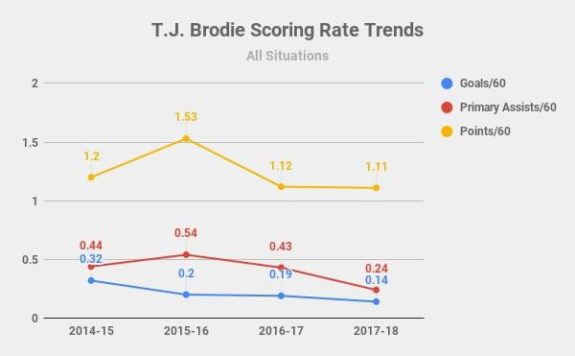
Second Stint as Calgary’s Most Used Pair
Since being put back together, Giordano and Brodie have been very good in 84 five-on-five minutes, the most on the team as no other Flames pair has played together more than 46 minutes. With them on the ice, the Flames have controlled 87.5 percent of goals and 56.3 percent of shots, both second on the team. The team has also attempted 34.8 shots and allowed 27.0 shots per-60 with them on the ice, second and third-highest on the team, respectively.
Relative to the league, the Giordano/Brodie pair ranks well, but not as well as Hamilton and Slavin. Giordano and Brodie are in the top-25 in all categories listed above, including second in control of goals. That’s among defense pairs with at least 50 shared five-on-five minutes.
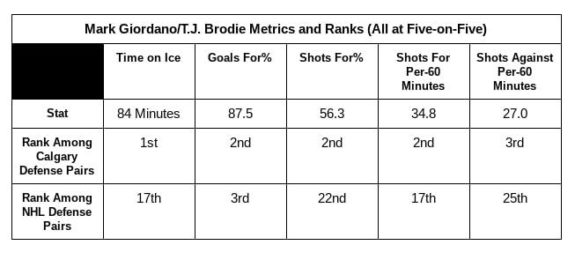
Giordano Picking up the Slack Again
During their first tenure as primary defense partners, Giordano was tasked with picking up Brodie and had to be the stronger of the two. In over 2,700 five-on-five minutes between 2013-14 and 2015-16, the pair had positive metrics in control of shots, goals, and scoring chances but fell just short of 50 percent in high danger scoring chances. Separately, Giordano had the higher metrics in control of shots, scoring chances, and high danger chances while Brodie outpaced him in goal control. It’s a similar story this season.
As a pair, the duo has dominated the metrics with at least 52 percent control in all four areas. Yet when either plays with different partner, their metrics suffer in general, although Giordano’s control of high danger chances with someone other than Brodie as his partner actually increased. When both defensemen are separate from each other, Giordano has the higher metrics in all but goal control, where both are at zero percent. It’s evident that Giordano anchors that pair.
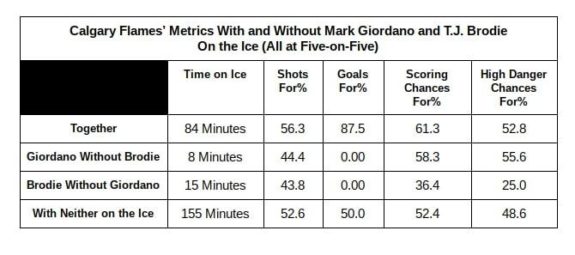
Both Players Will Continue to Be Fine
If there’s anything to learn from the trade that sent Hamilton to Carolina, it’s that both he and Giordano are exceptional defensemen in their own rights. They may have been one of the best pairs in the league the past two seasons, but each is still great apart from the other and should continue to be moving forward.
Hamilton has established a strong dynamic with Slavin and has added to what was already a solid crop of young defensemen in Carolina. He helped round out a top-four that already included Justin Faulk, Pesce, and Slavin, all 26 or younger. In Calgary, Giordano has found himself in familiar territory with Brodie as his partner and should help Brodie rebound.
Both Giordano and Hamilton should continue to have positive impacts on their teams. Both have proven that they are strong individual defensemen and their abilities to adapt could make the monumental trade that send Hamilton to Carolina a rare win-win for both the Flames and Hurricanes.
*All stats came from Natural Stat Trick and Corsica